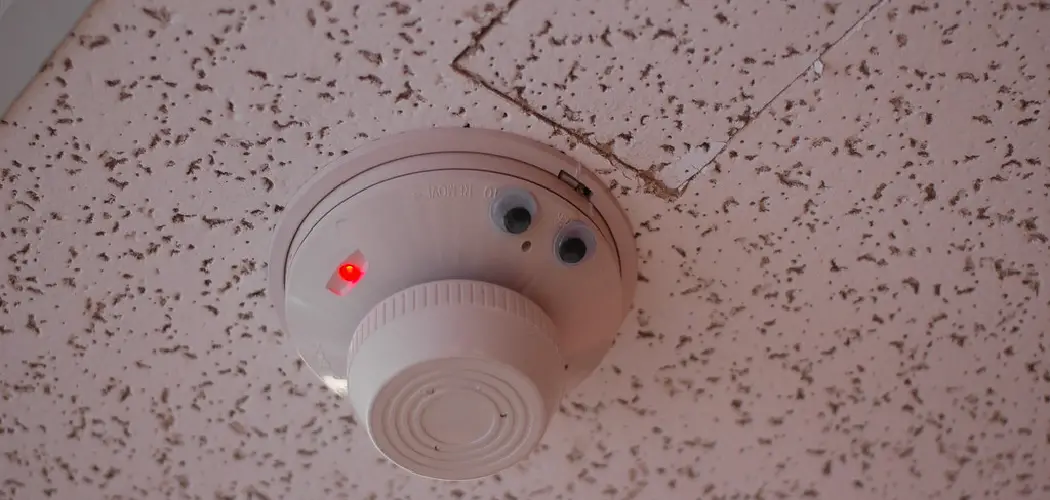Fire alarms are an essential safety feature in any building, but at times, they can cause unwanted disturbances due to false alarms or low batteries. In such cases, it may be necessary to remove the fire alarm cover for maintenance purposes or to replace the batteries. However, removing a fire alarm cover may seem like a daunting task for those who are not familiar with it.
In this guide on how to remove a fire alarm cover, we will explain the steps involved in removing a fire alarm cover safely and efficiently.
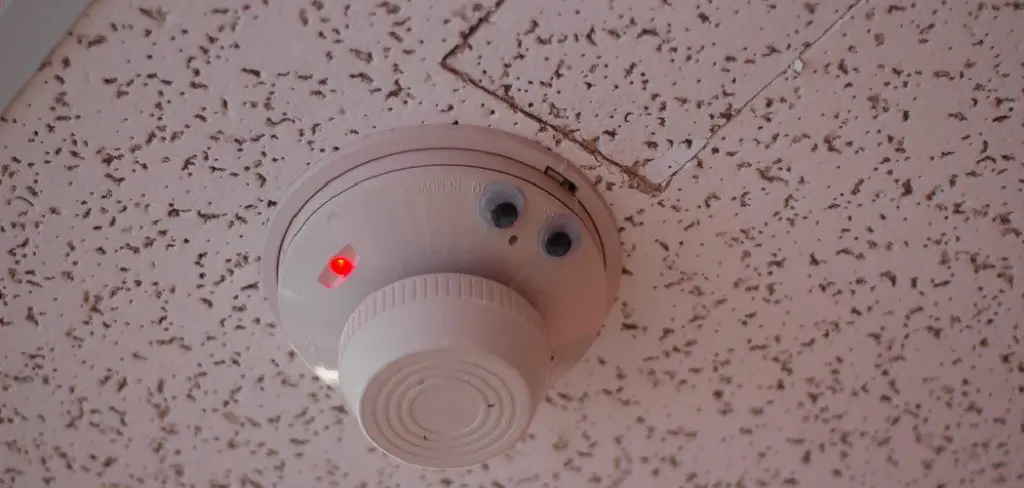
Necessary Items
Before attempting to remove a fire alarm cover, gather the following items:
- A ladder or step stool (if the alarm is mounted high on the ceiling)
- A screwdriver (usually Phillips head)
- Protective gloves and eyewear
12 Steps on How to Remove a Fire Alarm Cover
Step 1: Identify the Type of Fire Alarm
Before attempting to remove the fire alarm cover, it is important to determine which type of fire alarm you have. There are two main types – ionization smoke detectors and photoelectric smoke detectors. Ionization smoke detectors have a small amount of radioactive material that detects flames, while photoelectric smoke detectors use a beam of light to detect smoke.
Step 2: Turn Off Power
Before handling any electrical equipment, it is important to turn off the power. Locate the circuit breaker or fuse box and turn off the power supply to the fire alarm. Make sure to test the alarm before handling it to ensure that it is not receiving any power.
Step 3: Wear Protective Gear
Put on protective gloves and eyewear before attempting to remove the fire alarm cover. This will protect your hands from any sharp edges or debris and prevent any foreign objects from getting into your eyes.
Step 4: Find the Locking Mechanism
Depending on the type of fire alarm, the locking mechanism may vary. Some alarms have tabs that need to be pushed in, while others have small screws that need to be removed. Even though most fire alarms have a similar design, it is best to consult the manufacturer’s manual for specific instructions.

Step 5: Use a Ladder or Step Stool
If the fire alarm is mounted high on the ceiling, use a sturdy ladder or step stool to reach it safely. Make sure that it is properly positioned and stable before climbing up. While on the ladder, avoid overreaching and always maintain three points of contact for safety.
Step 6: Remove the Screws or Push in Tabs
Once you have located the locking mechanism, use a screwdriver to remove any screws or push-in tabs that are holding the cover in place. Be careful not to drop any screws or lose them, as they may be difficult to retrieve.
Step 7: Remove the Cover
Gently pull the cover off and set it aside in a safe place. Be careful not to tug on any wires that may be connected to the alarm. If the cover is stuck, do not use excessive force, as it may damage the alarm or cause injury.
Step 8: Remove and Replace Batteries (if needed)
If the reason for removing the cover is to replace the batteries, gently remove them and dispose of them properly according to local regulations. Then, insert new batteries following the correct polarity (indicated on the inside of the cover or in the manual).
Step 9: Check for Dust and Debris
While you have access to the fire alarm, take a moment to check for any dust or debris that may have accumulated inside. Use a soft cloth or compressed air to remove any buildup. However, be careful not to touch any sensitive components or use water.
Step 10: Clean the Cover
If the cover is dirty, use a damp cloth and mild detergent to clean it. Make sure it is completely dry before reattaching it to the fire alarm. Just like cleaning the inside, avoid using any harsh chemicals or excessive water.
Step 11: Reattach the Cover
Line up the cover with the alarm and gently push it back into place. Make sure that it is secure and properly locked in. If there were screws, reinsert them and tighten them securely. Also, make sure that any push-in tabs are properly engaged to ensure the cover stays in place.
Step 12: Turn On Power and Test
Once the fire alarm cover is securely back in place, turn on the power supply and carefully test the alarm. If it is functioning properly, you have successfully removed and replaced a fire alarm cover. Congratulations!
Removing a fire alarm cover may seem like a daunting task, but by following these simple steps, it can be done safely and efficiently. Remember to always wear protective gear, turn off the power supply, and consult the manufacturer’s manual for specific instructions.
It is also important to regularly test and maintain your fire alarms to ensure they are functioning properly in case of an emergency.
9 Safety Measures to Follow When Removing a Fire Alarm Cover
While removing a fire alarm cover may seem like a simple task, it is important to take certain safety measures to prevent any accidents or injuries.
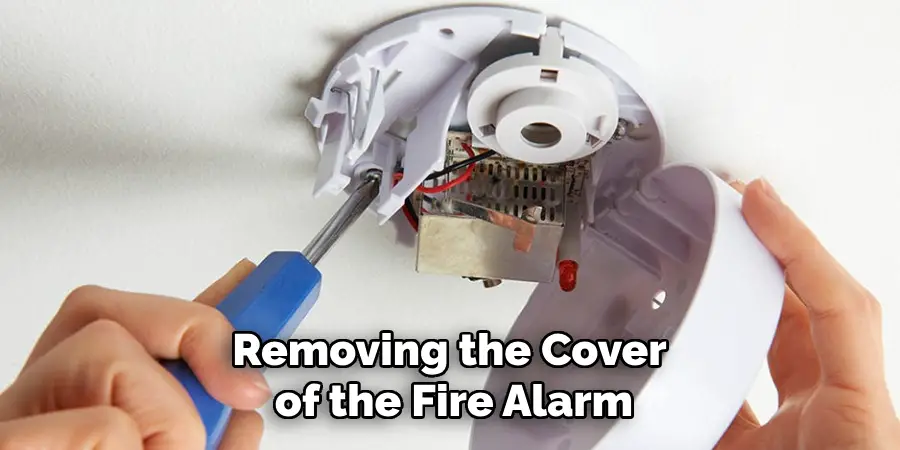
1) Wear Protective Gear
Always put on protective gloves and eyewear before handling the fire alarm. This will protect your hands from sharp edges or debris and prevent any foreign objects from getting into your eyes. So, never attempt to remove a fire alarm cover without proper protection.
2) Turn Off Power
Before handling any electrical equipment, make sure to turn off the power. This will prevent any electric shock or damage to the alarm. Also, test the alarm before handling it to ensure that it is not receiving any power.
3) Follow the Manufacturer’s Instructions
It is important to read and follow the manufacturer’s instructions for removing the fire alarm cover. Different alarms may have different locking mechanisms, so it is best to consult the manual for specific instructions.
4) Use a Ladder or Step Stool
If the fire alarm is mounted high on the ceiling, use a sturdy ladder or step stool to reach it safely. Make sure it is properly positioned and stable before climbing up. While on the ladder, avoid overreaching and always maintain three points of contact for safety.
5) Avoid Excessive Force
If the cover is stuck, do not use excessive force, as it may damage the alarm or cause injury. Instead, try to gently wiggle it loose or consult the manufacturer’s instructions for proper removal techniques.
6) Dispose of Batteries Properly
If you are removing the cover to replace the batteries, make sure to dispose of them properly according to local regulations. Never throw old batteries in the trash, as they may be hazardous. As an alternative, you can take them to a recycling center.
7) Do Not Touch Sensitive Components
While the cover is off, avoid touching any sensitive components inside the alarm. This could cause damage or interfere with its functioning. If there is dust or debris inside, use a soft cloth or compressed air to remove it gently.
8) Clean Cover and Alarm
Take the opportunity to clean both the cover and alarm while it is disassembled. Use a mild detergent and damp cloth to clean the cover and a dry cloth for any sensitive components inside. Avoid using harsh chemicals or excessive water.
9) Reattach Cover Properly
Make sure that the cover is reattached properly before turning on the power supply and testing the alarm. This will ensure that it is securely in place and functioning correctly. If there were screws or push-in tabs, make sure they are properly engaged.
By following these safety measures on how to remove a fire alarm cover, you can safely remove a fire alarm cover without causing any harm to yourself or the equipment. Remember to always exercise caution and consult the manufacturer’s instructions for specific guidelines.
8 Things to Avoid When Removing a Fire Alarm Cover
While there are certain safety measures to follow when removing a fire alarm cover, there are also some things that you should avoid. These can lead to accidents, damage to the alarm, or hinder its proper functioning.
1) Using Excessive Force
As mentioned before, using excessive force can cause damage to the alarm or injury to yourself. Instead of pulling or prying too hard, try to gently wiggle the cover loose or consult the manufacturer’s instructions.
2) Not Wearing Protective Gear
Always wear protective gloves and eyewear when handling a fire alarm. This will protect your hands from sharp edges and prevent any foreign objects from getting into your eyes. Keep in mind that fire alarms may have dust or debris inside, so it is best to wear a mask as well.
3) Not Turning Off Power
Never attempt to remove a fire alarm cover without turning off the power supply first. This can lead to electric shock or damage to the alarm. Also, make sure to test the alarm before handling it to ensure it is not receiving any power.
4) Overreaching on a Ladder
When using a ladder or step stool to reach the alarm, avoid overreaching. This can cause the ladder to shift and lead to a fall. For stability, always maintain three points of contact while on the ladder. Some alarms may also have a weight limit, so be mindful of that as well.
5) Touching Sensitive Components
It is important to avoid touching any sensitive components inside the alarm while the cover is off. This could potentially damage the equipment or interfere with its functioning. If there is dust or debris inside, use a soft cloth or compressed air to remove it gently.

6) Not Properly Disposing of Batteries
If you are removing the cover to replace batteries, make sure to dispose of them properly according to local regulations. Do not throw old batteries in the trash, as they may be hazardous. Instead, take them to a recycling center for proper disposal.
7) Using Harsh Chemicals
Avoid using harsh chemicals or excessive water when cleaning the cover and alarm. This can damage the equipment or interfere with its functioning. Instead, use a mild detergent and damp cloth for the cover and a dry cloth for any sensitive components inside.
8) Not Reattaching Cover Properly
Lastly, make sure to reattach the cover properly before turning on the power supply and testing the alarm. This will ensure that it is securely in place and functioning correctly. If there were screws or push-in tabs, make sure they are properly engaged.
By avoiding these things when removing a fire alarm cover, you can ensure a safe and successful removal process. Remember to always prioritize your safety and consult the manufacturer’s instructions for specific guidelines.
8 Additional Tips for Removing a Fire Alarm Cover
Aside from following safety measures and avoiding certain actions, there are also some additional tips that can make removing a fire alarm cover easier and more efficient.
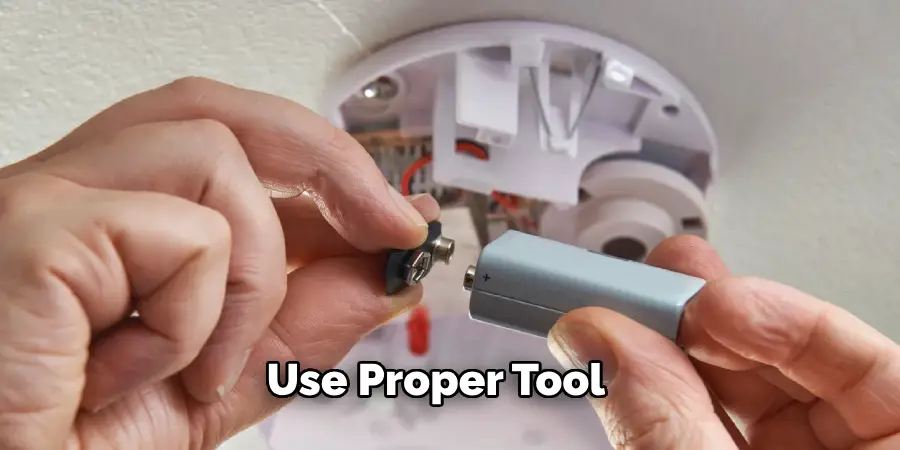
1) Use Proper Tools
Make sure to have the necessary tools on hand before attempting to remove a fire alarm cover. This may include a screwdriver, ladder or step stool, gloves and good eyewear. Using the correct tools can make the process safer and more efficient.
2) Have a Helper
If possible, have someone assist you when removing a fire alarm cover. They can hold the ladder or hand you tools while you work, making the process smoother and safer. Also, if any accidents do occur, there will be someone to help you.
3) Read the Manufacturer’s Instructions
Always refer to the manufacturer’s instructions for specific guidelines on removing the cover. They may have specific tools or techniques recommended for their particular model of fire alarm. But if you are unsure, seek professional help.
4) Check for Screws or Tabs
Before attempting to remove the cover, check for any screws or push-in tabs that may be securing it in place. This will prevent you from pulling too hard and potentially damaging the alarm. If there are any, make sure to properly engage them after cleaning and before testing the alarm.
5) Test the Alarm
Before handling the alarm, make sure to test it to ensure it is not receiving any power. This will prevent electric shock or damage to the equipment. If the alarm does go off while you are removing the cover, immediately stop and seek professional assistance.
6) Clean Cover and Alarm
Take advantage of having the cover off to clean both the cover and the inside of the alarm. This will help remove any dust or debris that may have accumulated, ensuring proper functioning. Just be careful not to touch any sensitive components.

7) Check for Battery Replacement
If you are removing the cover to replace batteries, make sure to check for any expiration dates on the new batteries. If they are expired, do not use them and dispose of them properly. It is also helpful to mark the date of replacement on the new batteries.
8) Document the Process
Lastly, it may be beneficial to document the process of removing the alarm cover, especially if you are unfamiliar with the equipment. This can serve as a reference for future maintenance or replacement and help ensure proper reinstallation. Remember, when in doubt, it is always best to seek professional assistance to remove a fire alarm cover.
With these tips and precautions on how to remove a fire alarm cover, you can safely and effectively remove the cover without causing any damage or harm. Always prioritize safety and follow proper procedures to ensure the optimal functioning of your fire alarm system.
Frequently Asked Questions
Can I Remove a Fire Alarm Cover Without Turning Off the Power Supply?
No, it is not safe to remove a fire alarm cover without turning off the power supply first. This can lead to electric shock or damage to the equipment. Always make sure to turn off the power supply and test the alarm before handling it.
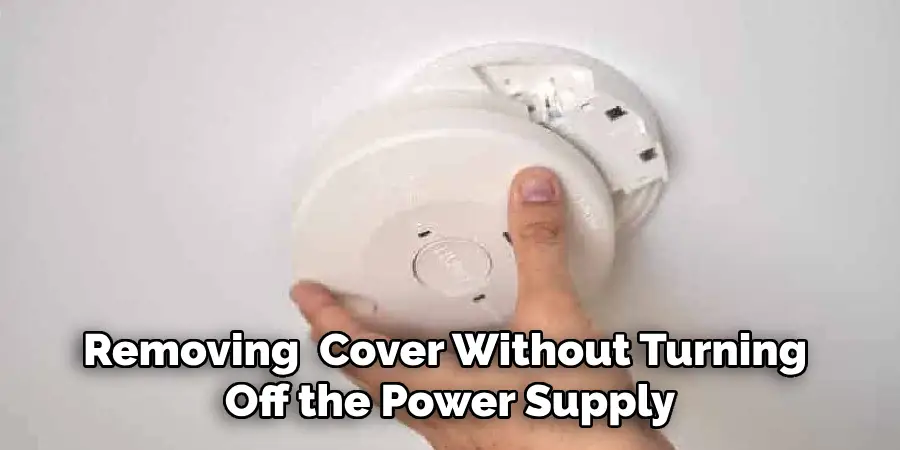
How Often Should I Replace Batteries in My Fire Alarm?
It is recommended that you replace the batteries in your fire alarm at least once a year. However, it is important to check for any expiration dates on the batteries and replace them sooner if necessary.
Can I Use Harsh Chemicals to Clean My Fire Alarm Cover?
No, it is not recommended to use harsh chemicals or excessive water when cleaning a fire alarm cover. This can damage the equipment and interfere with its functioning. Use a mild detergent and damp cloth instead.
What Should I Do if the Alarm Goes Off While Removing the Cover?
If the alarm goes off while removing the cover, immediately stop what you are doing and seek professional assistance. This could indicate a faulty or sensitive alarm, and it is best to have an expert assess the situation.
Is It Necessary to Reattach the Cover Properly After Cleaning?
Yes, it is crucial to reattach the cover properly after cleaning. This will ensure that it is securely in place and functioning correctly when testing the alarm. If there were screws or push-in tabs, make sure they are properly engaged. So, it is essential to follow these tips while removing the fire alarm cover for the safety and efficient functioning of the equipment.
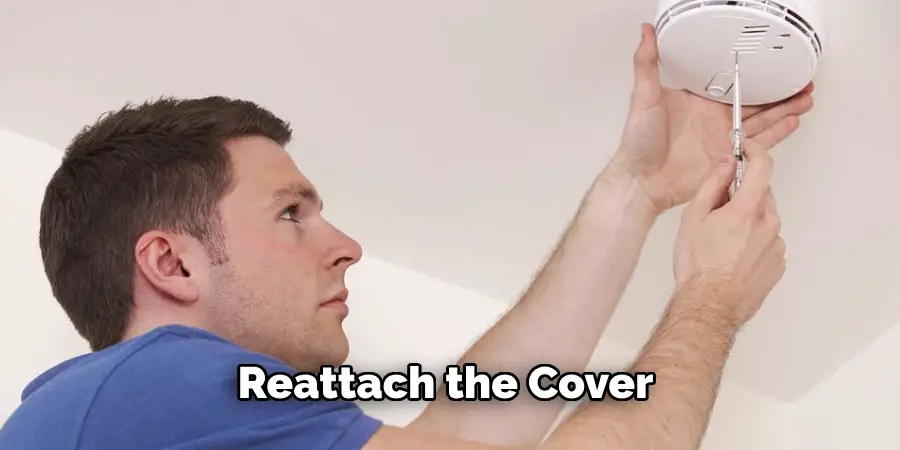
Conclusion
Removing a fire alarm cover may seem like a simple task, but it is important to prioritize safety and follow proper procedures. Always turn off the power supply and test the alarm before handling it, check for screws or tabs, use proper tools, and have a helper if possible. Clean both the cover and the inside of the alarm before reattaching it properly. Remember to replace batteries regularly and document the process for future reference.
By following these additional tips and precautions on how to remove a fire alarm cover, you can ensure a safe and successful removal of your fire alarm cover. Stay safe and always seek professional help if unsure or uncomfortable with the process. Your safety is paramount when dealing with any fire safety equipment.

